A visual history of campus protests in the US
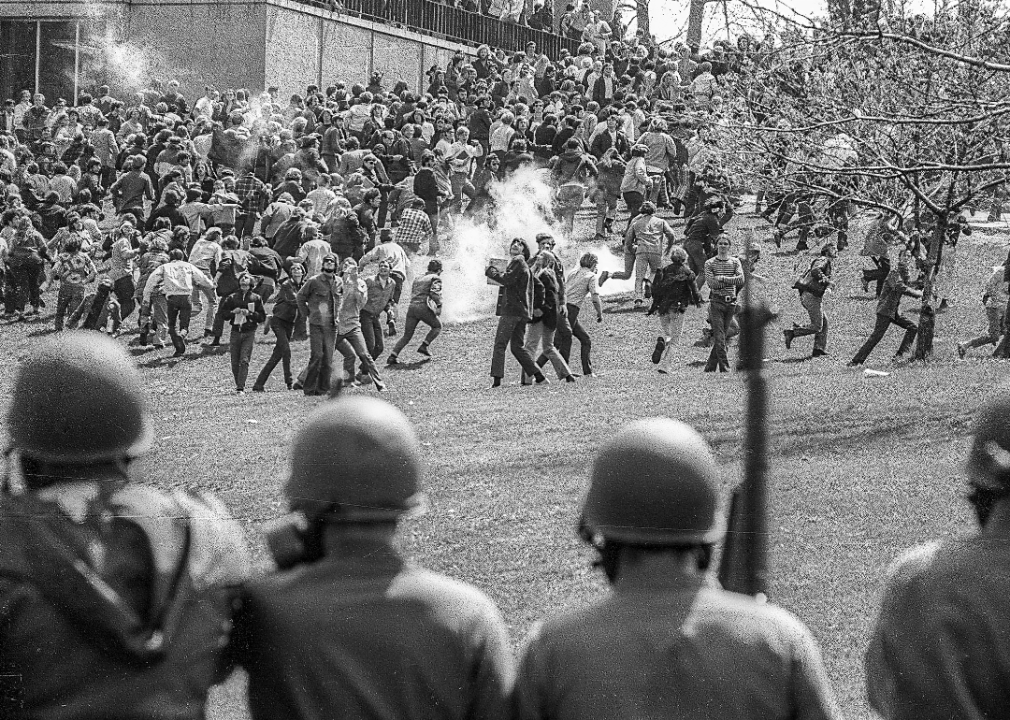
Howard Ruffner // Getty Images
A visual history of campus protests in the US
National Guardsmen in gas masks with rifles drive back Kent State University students.
The current wave of pro-Palestinian protests on college campuses has thrust the long history of student activism in the United States into the national spotlight.
The student-led rallies, encampments, and building takeovers that began at Columbia University in New York City on April 17 and spread to campuses nationwide are not without precedent. Nor are the varied outcomes of the protests. From authorities clamping down on protestors to instances of violence and destruction—and, in some cases, peaceful resolution—echoes of the past are present in pro-Palestinian demonstrations today.
Stacker curated a collection of photographs of student-led demonstrations from the last century to contextualize the history of protest movements on American college campuses.
Campus protests trace back at least a century to Fisk University, where protests in the 1920s against then-campus President Fayette McKenzie served as a precursor to the Civil Rights Movement. From hunger strikes during the Vietnam War to recent “die-ins” pushing for gun control reform, campus activism has long challenged political and social norms, often bringing simmering issues to the forefront of public consciousness.
College protests have long drawn attention to issues of racial and gender equity, at times advancing or pushing back against legislation. In 1976, the women’s crew team at Yale staged a “strip-in” to protest their lack of resources, an early flex of Title XI legislation. Nearly five decades later, students at the University of Austin, Texas, marched for a different sort of autonomy, going to the State Capitol in protest of the state’s impending sweeping abortion ban.
Pro-Palestinian protestors say their goals include expressing solidarity with Palestinian rights and raising awareness about the rising death toll and ongoing humanitarian crisis in Gaza. Some groups are calling for universities to sever financial ties with companies they see as benefiting from Israel’s military campaign in Gaza, an offensive launched in response to the Oct. 7, 2023, attacks.
Not all protests have proceeded—or ended—peacefully. Some students have offered stark examples of protests that cross the line from criticism of Israel into antisemitism. Classmates, in certain instances, attest to the hostile environment for Jewish students and threats to their safety.
After weeks of escalating tensions on campuses, in early May, law enforcement was called in at various universities across the country to break up pro-Palestinian encampments and disperse students. Some resulted in skirmishes and arrests; others took a violent turn. At least four universities, however, have seen peaceful outcomes. At Rutgers University in New Jersey and Brown University in Rhode Island, students agreed to dismantle encampments after the administration agreed to consider their demands.
While commentators have been quick to draw parallels between 2024 and the social justice movements of 1968, making historical comparisons is always thorny—particularly when complex issues are reduced to single events or examples.
The current movement faces a particular challenge in balancing students’ right to congregate and speak freely with the right for all students to feel safe on campus. Each movement is unique, as the photos below attest.
![]()
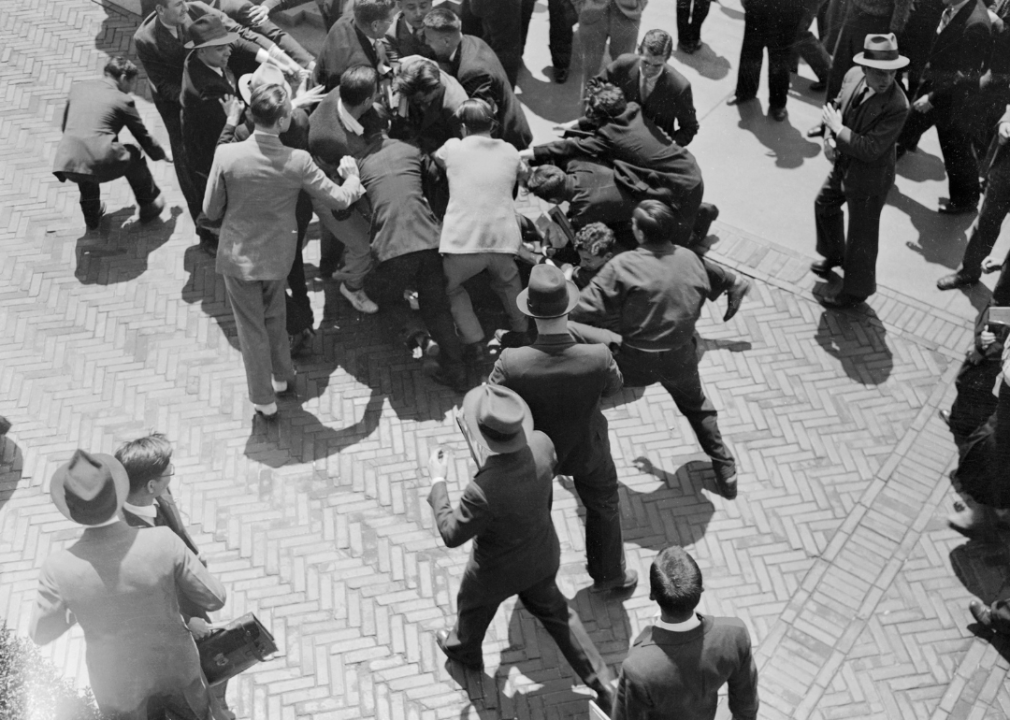
Bettmann // Getty Images
1933: Columbia University students strike in defense of ‘academic freedom’
Students battle at Columbia University, New York, in 1933, in defense of “academic freedom.”
In 1933, Columbia failed to reappoint Donald Henderson, an economics instructor who was ostensibly let go because of his role as a Columbia Social Problems Club leader. In other words, Henderson liaised with communists or was one himself. Protesters in support of Henderson fought hand-to-hand with supporters of the opposition, and police broke up the fighting with nightsticks. Even famed Mexican artist Diego Rivera got in on the action.
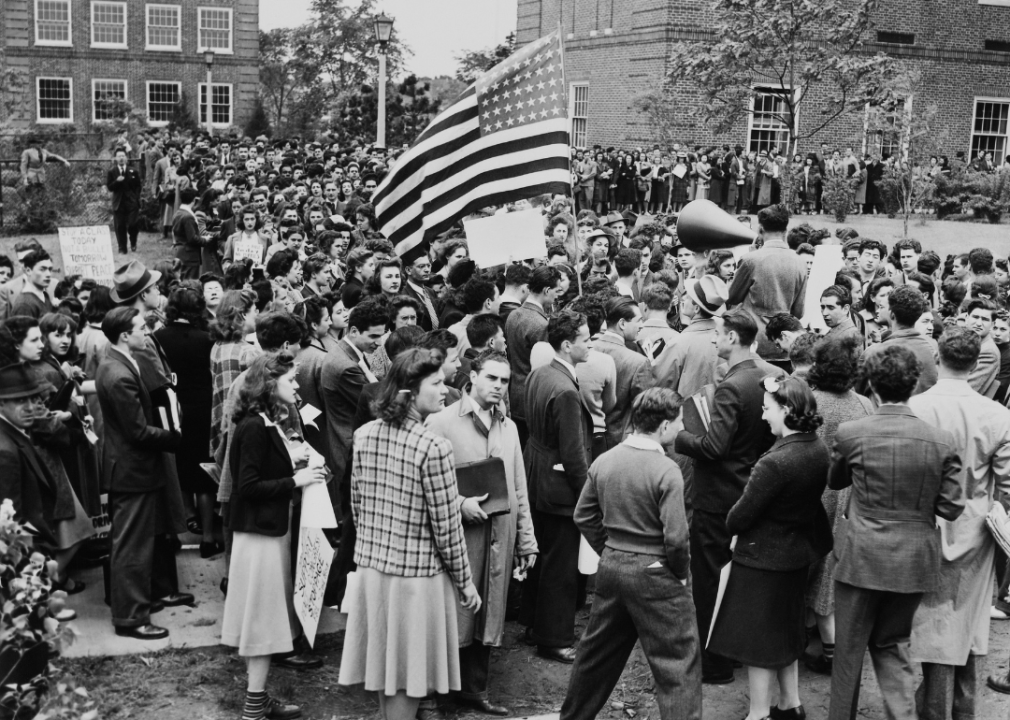
Keystone-France/Gamma-Keystone via Getty Images
1940: Students for Peace protest America’s involvement in WWII
Students gather on a college campus with a bullhorn and an American flag.
While many World War II images depict young people proudly going off to serve their country, there was opposition among them. Campus groups like Students for Peace Against Involvement of America in War and early pacifist organizations like the War Resisters League set the foundation for “revolutionary nonviolence.” Student concerns included imperialism, colonialism, and profiteering from war.
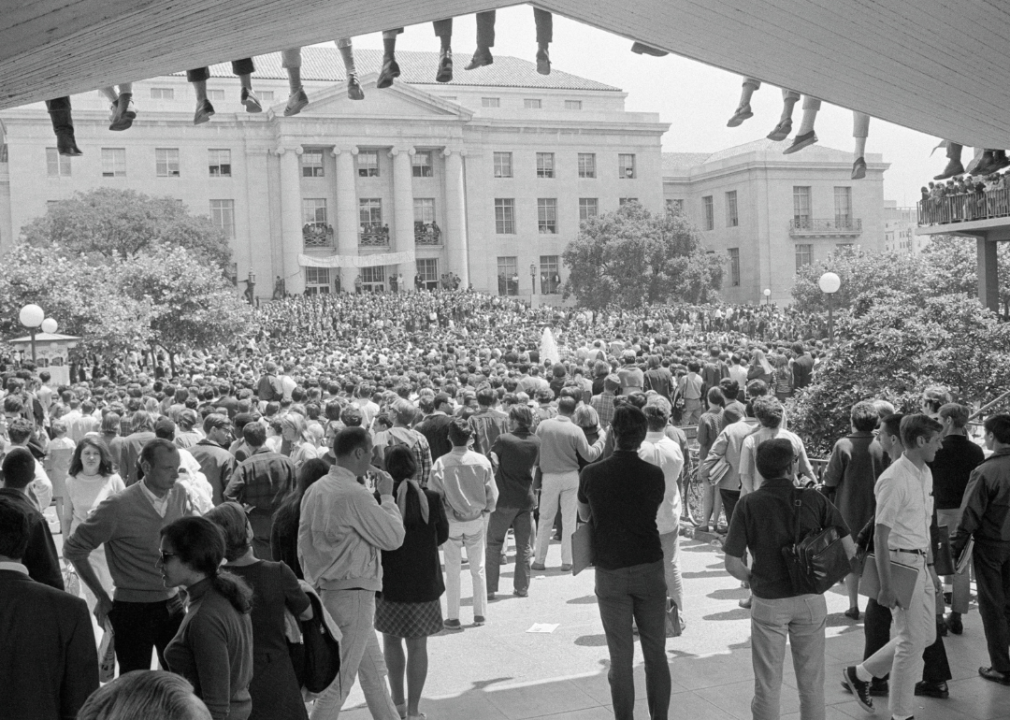
Bettmann // Getty Images
1968: UC Berkeley’s anti-draft ‘Vietnam Commencement’
Thousands of students attend an anti-draft protest
In a somber ceremony, thousands of students attended an anti-draft “Vietnam Commencement” at the University of California, Berkeley, where some pledged to refuse military service. The 1968 ceremony, which resembled a graduation, took place in Berkeley’s Sproul Hall, the current site of a pro-Palestinaian sit-in. The school had already been famous for protests in 1964 during the student-led Free Speech Movement (anti-war, civil rights). Though the Vietnam War would drag on for another six years, 1968 was an inflection point for conscientious objectors, often young men ages 18 to 35 eligible for conscription under the Selective Service Act.
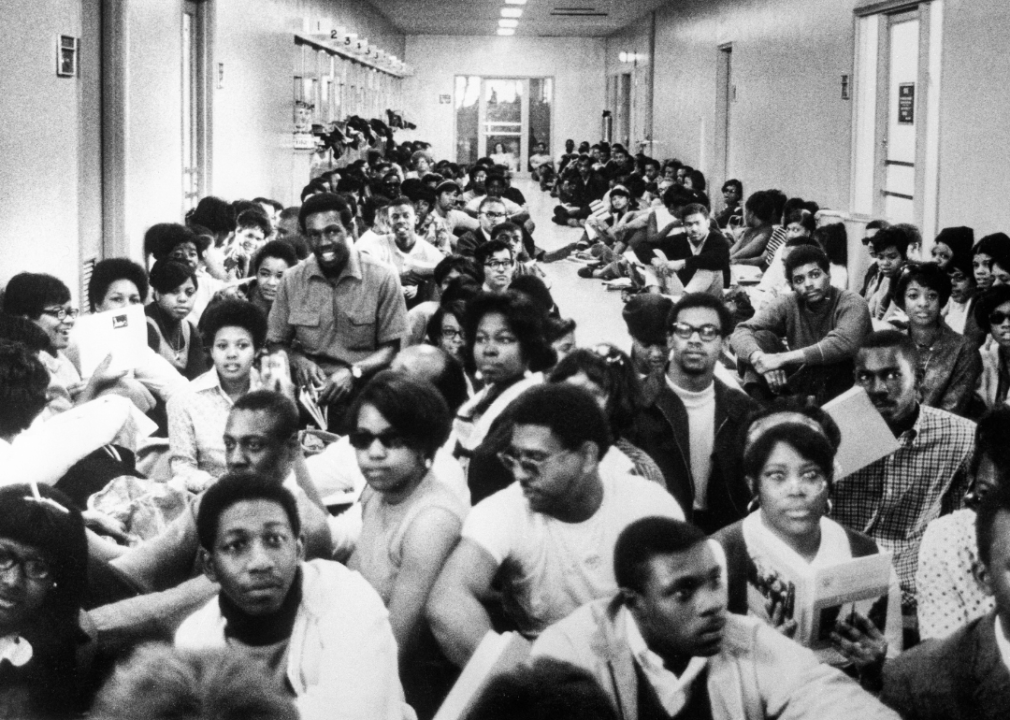
Bettmann Archive // Getty Images
1968: Howard University students call for radical administration change
Students seated in a hallway at Howard University.
In 1968, Howard University students took over an administrative building to demand drastic changes at the storied historically Black university. Among their conditions were a greater emphasis on African-American studies and a change in administrative leadership. “Our demand is an answer—we want you to say publicly what you think about these issues,” Adrienne Manns Israel, one of the original protest organizers, told the Zinn Education Project.
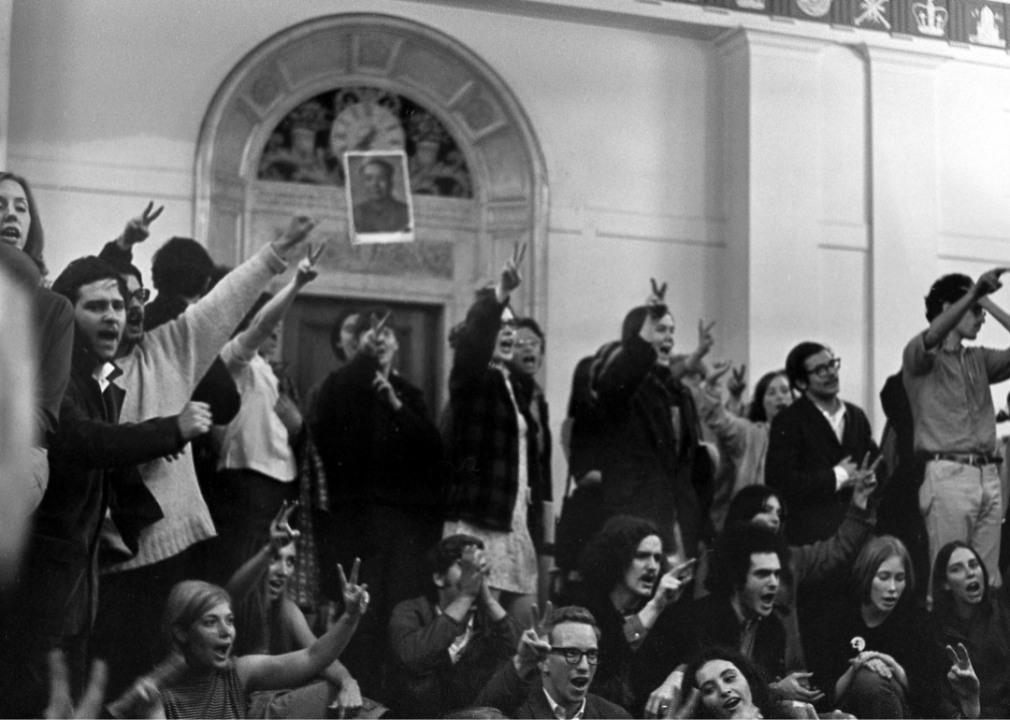
Bev Grant // Getty Images
1968: Students for a Democratic Society occupies Hamilton Hall at Columbia University
Students occupy Hamilton Hall at Columbia University.
Protests culminated from the Civil Rights Movement, anti-Vietnam War sentiment, and the discovery that Columbia was financially tied to arms supporting the Vietnam War. More than 1,000 protesters took over five buildings and the dean was taken hostage. The events at Columbia were later called “the most powerful and effective student protest in modern American history” in historian Mark D. Naison’s 2002 memoir, “White Boy.”
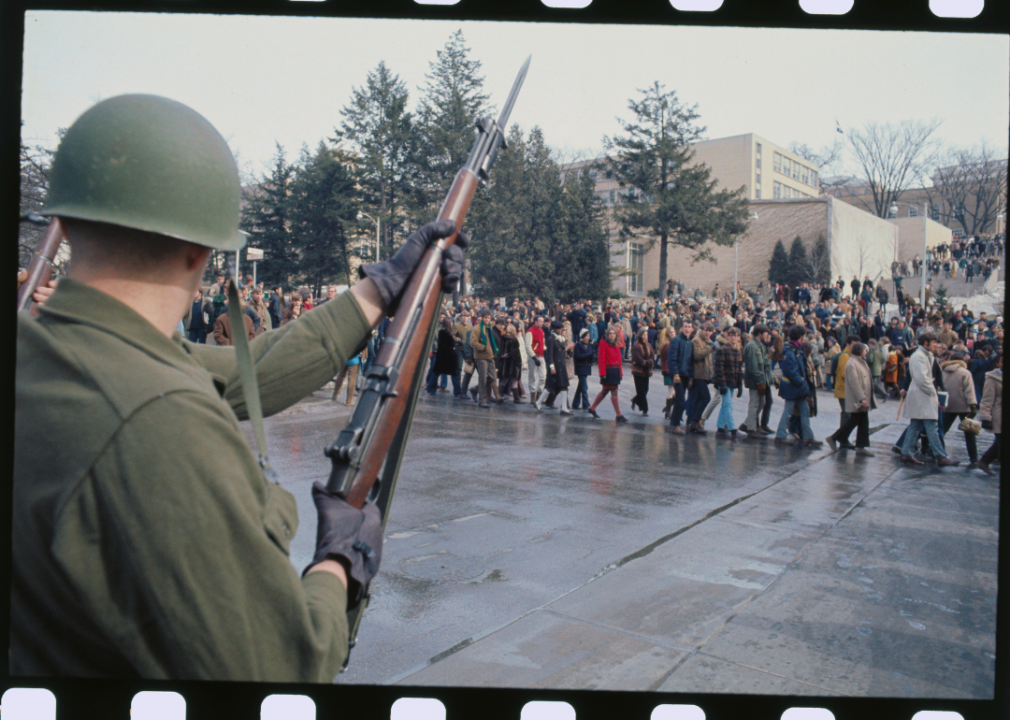
Bettmann // Getty Images
1969: Black Student Strike at the UW Madison
National Guardsmen and University of Wisconsin students.
During the same period of the uprising, the Black Students Strike at the University of Wisconsin–Madison pushed the administration to comply with a list of “non-negotiable” demands, including instituting a Black Studies Department and admitting at least 500 Black students the next semester. During the two-week protest, the governor activated the Wisconsin National Guard, a move that galvanized even more protesters to come out and march to the capital.
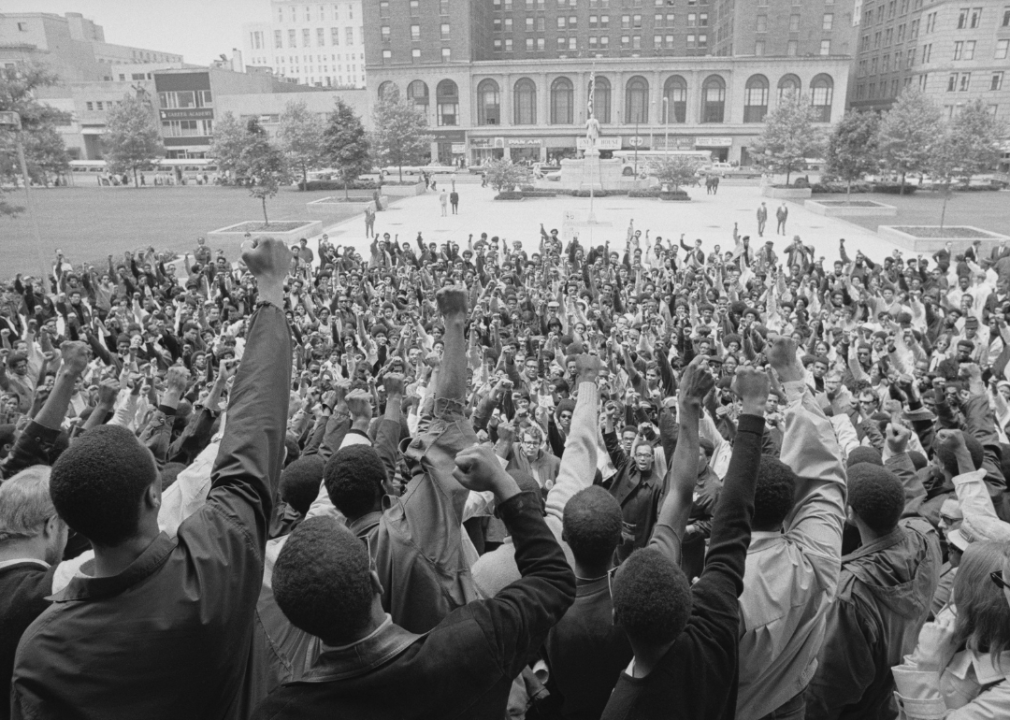
Bettmann // Getty Images
1969: Central State University students assemble in Columbus, Ohio, to oppose admissions policies
Students from Central State University give the black power salute during a meeting on the steps of the State House
As the oldest private historically Black university in the nation and the site of a stop on the Underground Railroad, Central State University has activism in its DNA. In 1969, students pressed the administration for more funding and an end to the limit on students admitted from out of state. During a meeting on the steps of the State House, students showed solidarity with the black power salute.
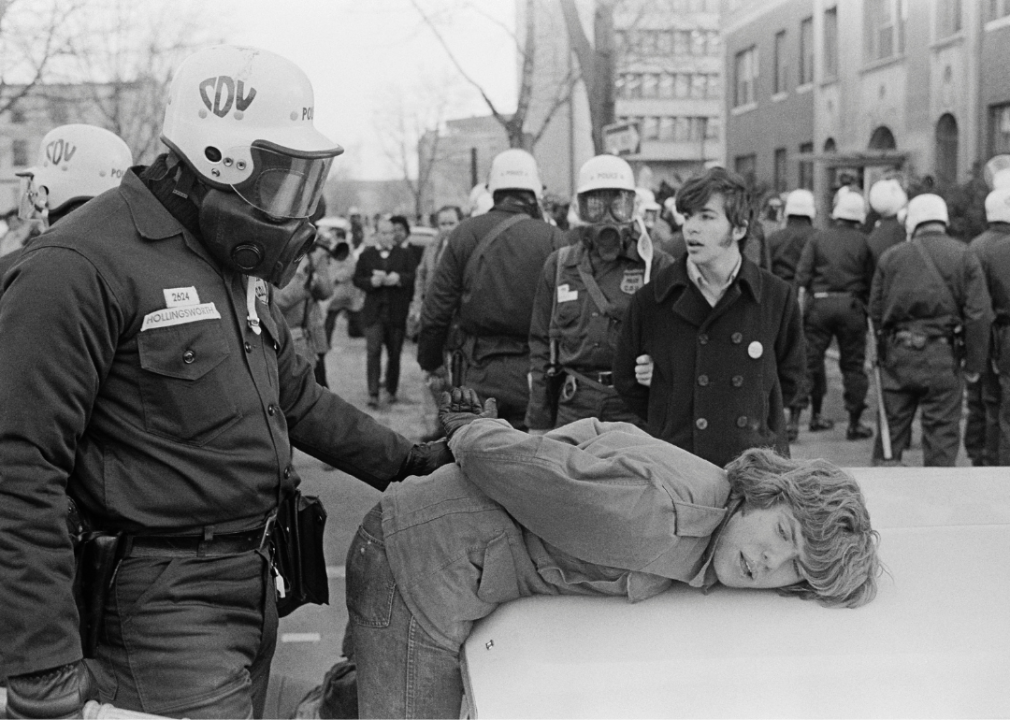
Wally McNamee/CORBIS/Corbis via Getty Images
1970: GW University students carry on anti-war demonstrations near Watergate complex in DC
Police wearing helmets and gas masks arrest anti-war demonstrators.
George Washington University, once dubbed the “Holiday Inn of the Revolution” for hosting anti-war protestors in dorms, has a long history of campus activism dating back to the Civil War. During the Vietnam era, anti-war demonstrators faced off with DC Metro police as they marched to the locus of Republican power, the Watergate Complex (interestingly, designed by Mussolini’s favored architect) that soon would become notorious for the eponymous scandal.
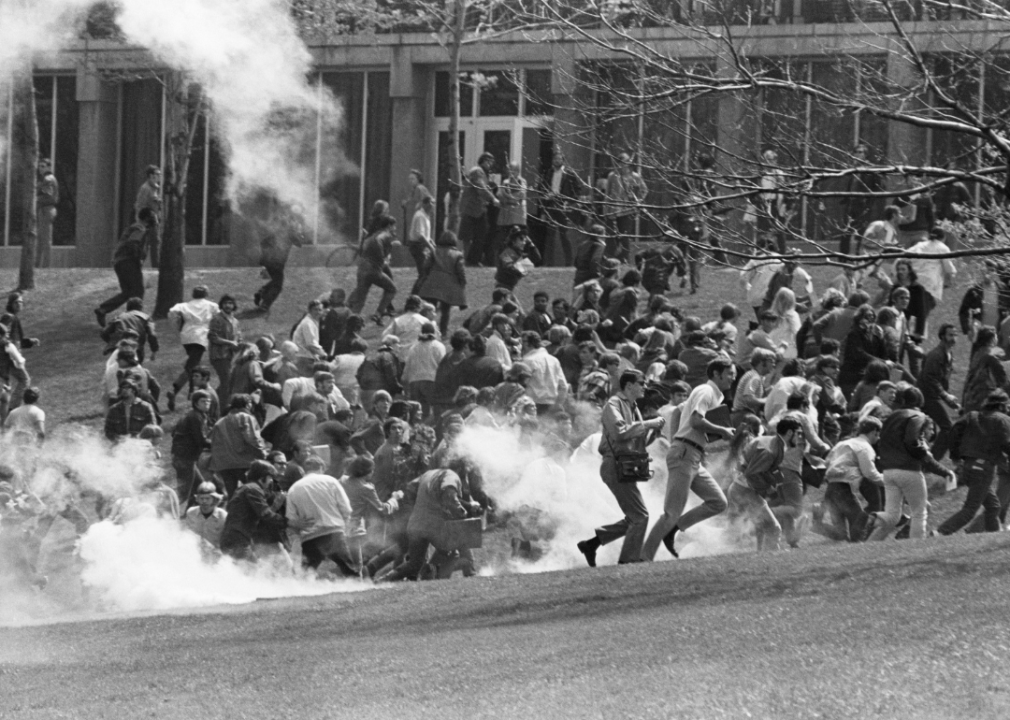
Bettmann // Getty Images
1970: Protests erupt following Kent State shootings
Demonstrators flee tear gas at Kent State.
May 4, 1970, is branded in national memory as a day of tragedy at Kent State University. During a protest calling for the end of the war in Vietnam, the Ohio National Guard fired into a crowd, killing four students and injuring nine. Other students were met with tear gas and rubber bullets. The horrific event became a flashpoint in the national upheaval over the United States’ involvement in Southeast Asia.

JSU Communications/Jackson State University/Historically Black Colleges and Universities via Getty Images
1970: Students protest racial injustice at Jackson State College
People gather outside women’s dormitory Alexander Hall at Jackson State College in Mississippi.
Weeks after the Kent State shootings, another tragedy took place at a protest against racial injustice outside of Alexander Hall at Jackson State College in Mississippi. Students at the historically Black college were gathered by the dormitory—some protesting, others not—when the police opened fire. Two students were killed and 15 wounded. The incident didn’t receive as much public attention as Kent State, the officers were never charged, and the Black families of the victims were not awarded damages.
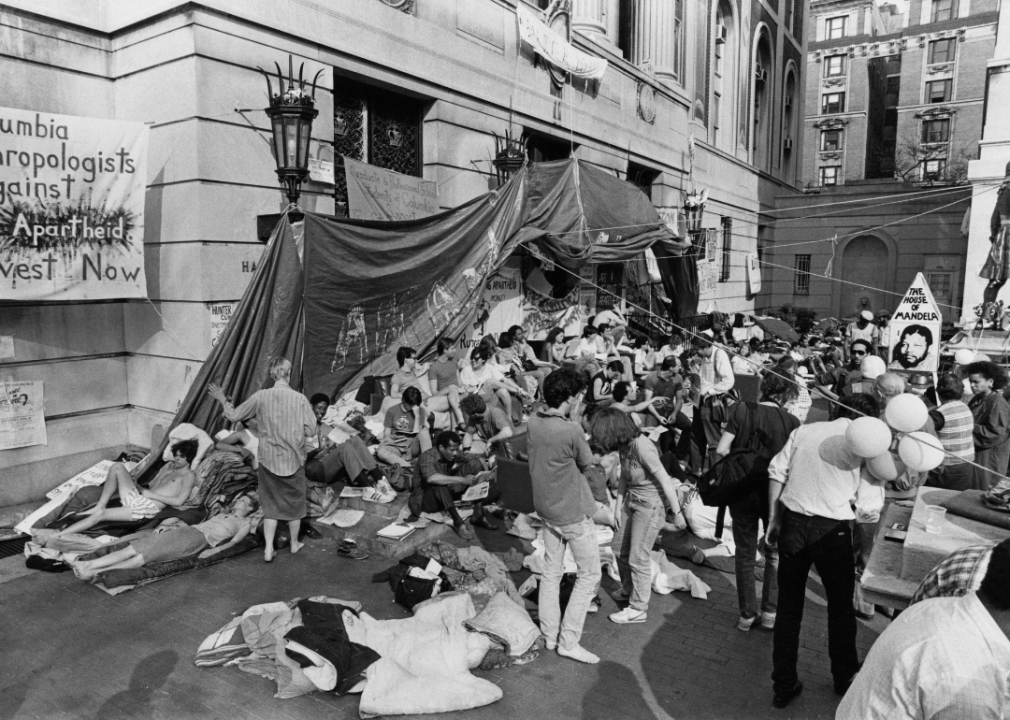
Barbara Alper/Getty Images
1985: Students camp out at Columbia University’s Hamilton Hall to protest apartheid
Students camp out in front of Hamilton Hall at Columbia University.
During the Anti-Apartheid Movement, protestors at Columbia University demanded that the university withdraw its investments in South Africa. The protest would set a precedent at the school, where calls for divestment continued into the 21st century when Columbia withdrew investment funds from fossil fuels and private prison companies after student campaigns. Pro-Palestinian protestors occupied the same building to call for divestment from Israel 56 years later, almost exactly to the day.
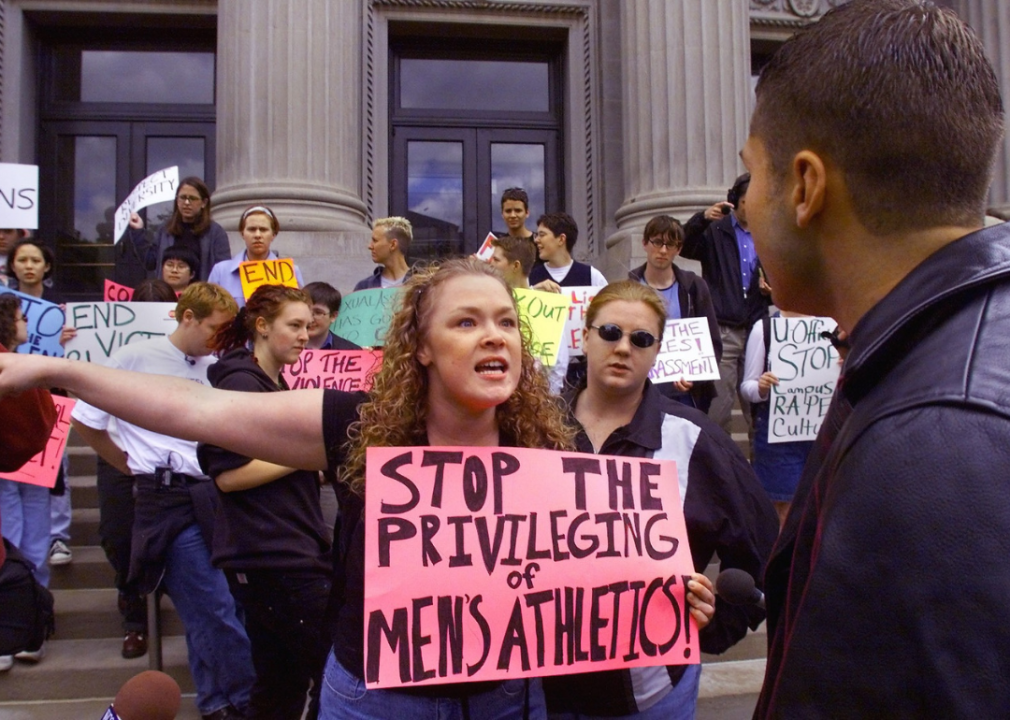
BRUCE BISPING/Star Tribune via Getty Images
1999: University of Minnesota students demand action regarding sexual conduct investigations
Students hold placards in protest at the University of Minnesota.
Long before the #MeToo movement, members of feminist and advocacy groups raised awareness about violence against women by staging demonstrations at the University of Minnesota to protest the protection of athletes accused of sexual misconduct. Among them included the Gender Liberation Action Front and advocates against sexual violence, who led a peaceful demonstration while demanding action against athletic officials who allegedly intervened in assault and sexual conduct investigations involving athletes.
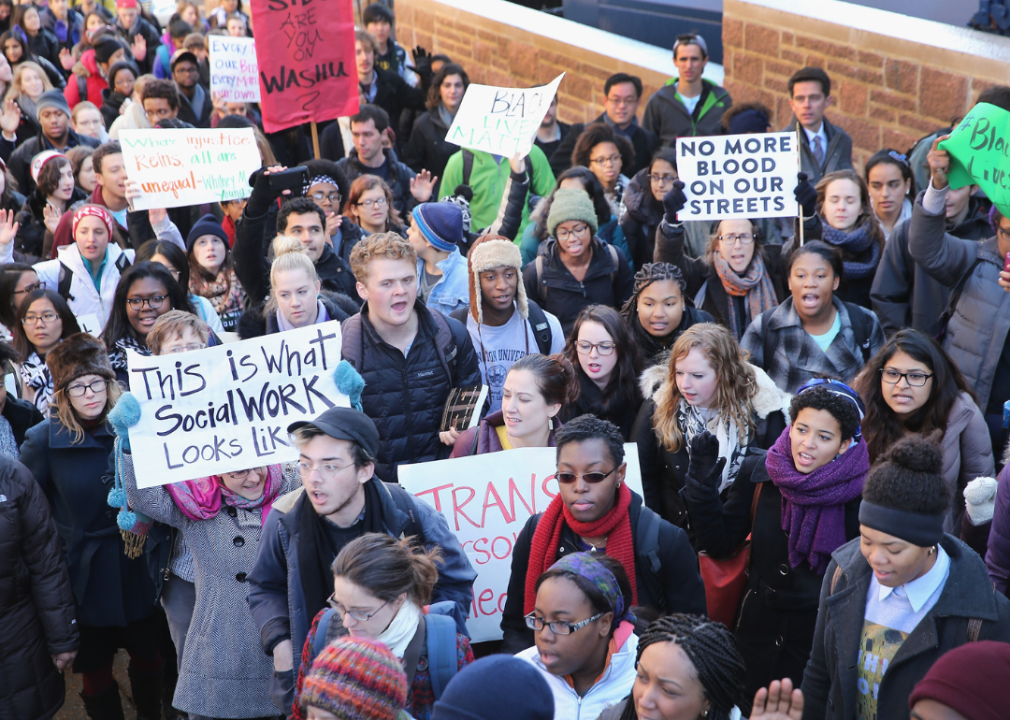
Scott Olson // Getty Images
2014: Washington University students protest to draw attention to police abuse
Students at Washington University protest with signs and posters
When Michael Brown, an unarmed Black man, was killed in Ferguson, Missouri, by white police officer Darren Wilson, protesters at nearby Washington University in St. Louis raised awareness about ongoing police injustices with “hands up” walkouts. Later that year, when a grand jury determined Wilson would not face criminal charges, protests erupted across the nation and thrust the Black Lives Matter movement into the national spotlight.
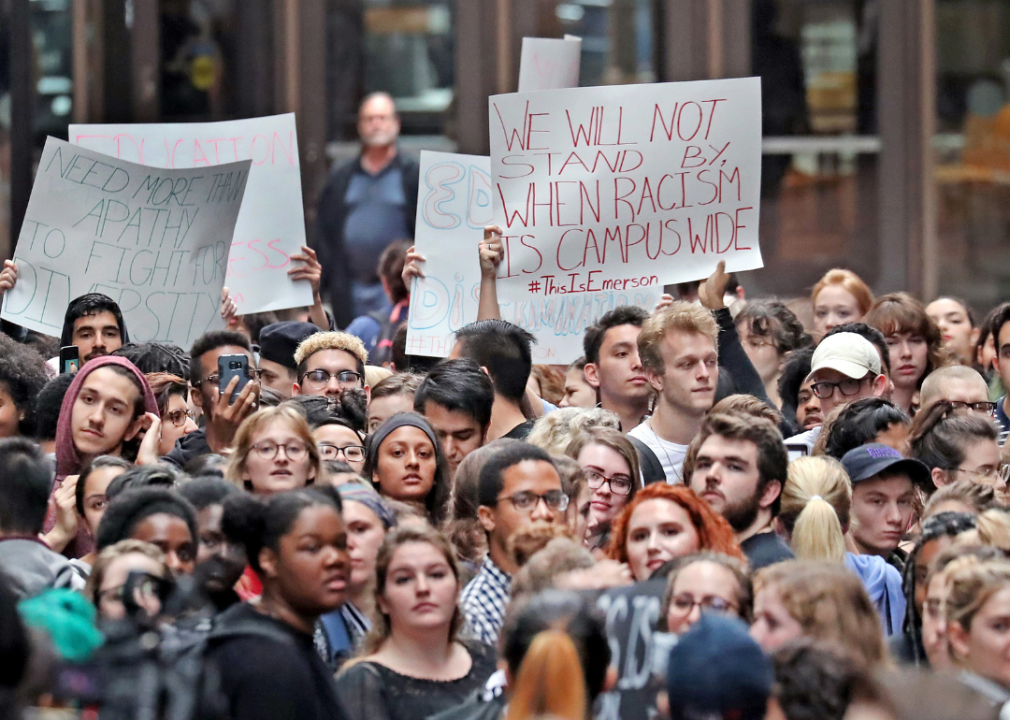
David L. Ryan/The Boston Globe via Getty Images
2017: Emerson College students walk out to protest on-campus racism
Emerson College students stage a walkout in Boston.
In 2017, about 200 Emerson College students walked out of class to protest the administration’s inadequate response to racism on campus. Marching to a nearby theater where about 80 faculty members were gathered, they chanted, “No more oppression, no microaggressions,” and called for the administration to do more than go beyond “surface-level progress.”
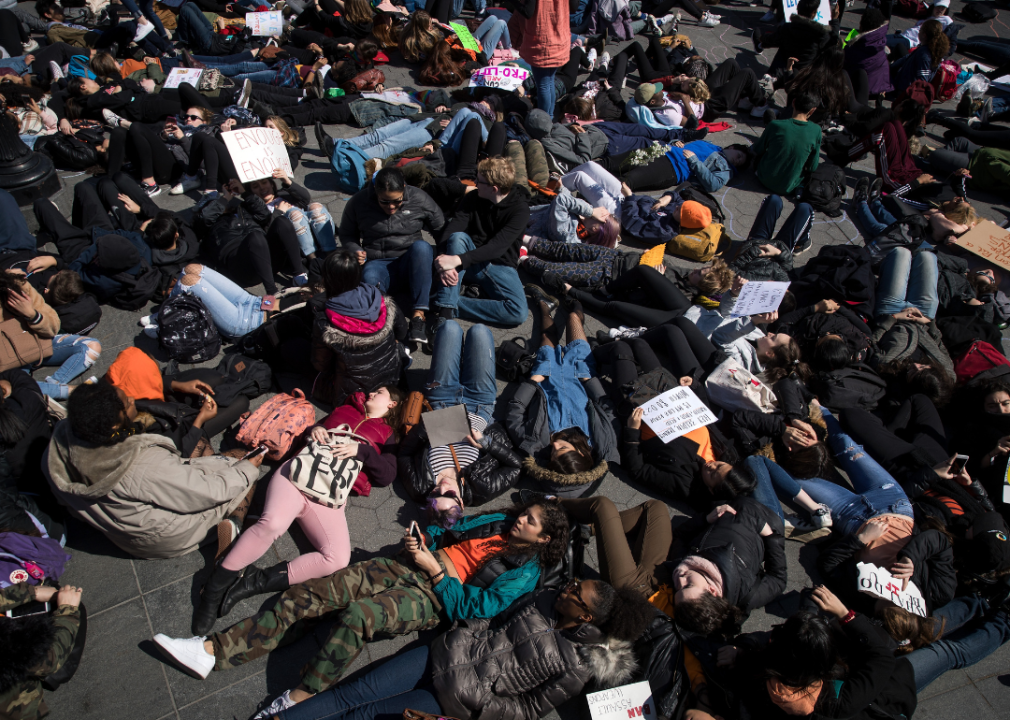
Drew Angerer // Getty Images
2018: Student activists lead ‘die-in’ protesting gun violence at NYU
Students lie on the ground in Washington Square Park.
In 2018, New York University students participated in a “die-in” on the 20th anniversary of the 1999 Columbine High School mass shooting. They were joined by activists from around the nation demonstrating their frustration with relentless gun violence by protesting with stillness and silence on campuses and in public spaces. Driven by young people, movements like March for Our Lives amplified calls for gun control reform and pushed for legislation in recent years.
So far, as of April 2024, there have been 66 occurrences of gunfire on school grounds this year alone, resulting in 26 deaths.
Story editing by Nicole Caldwell. Copy editing by Paris Close. Photo selection by Michael Flocker.